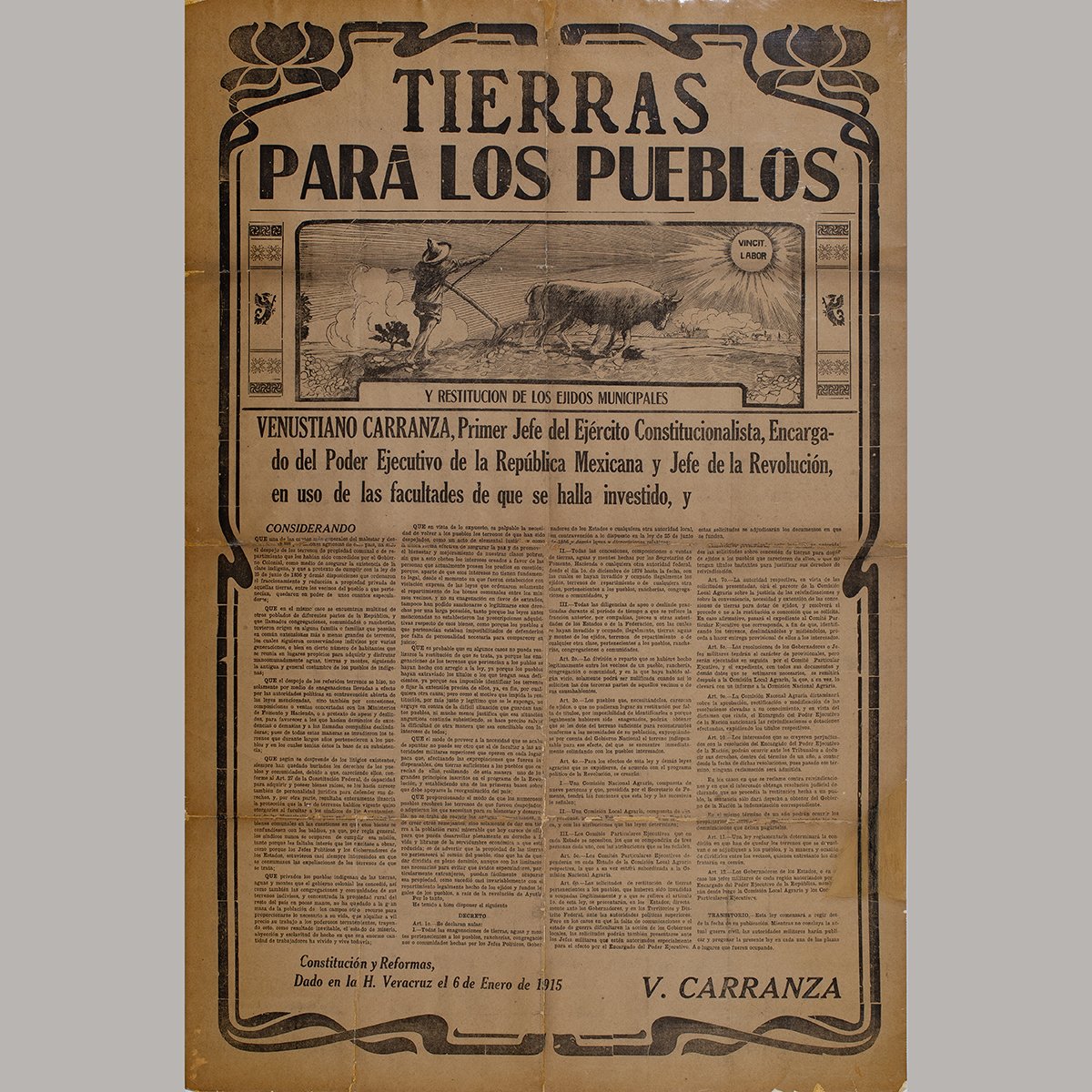Broadside of Mexican Revolution
"Agrarian Law of 1915"
Height 34" Width 22 1/2"
Provenance: Private Collection, Silver City, NM
This very rare broadside is connected to the significant efforts toward land reform and was a milestone in the Mexican Revolution. The overwhelming loss of the peasant, village, and indigenous lands to large estates and business interests in Mexico during the long reign of Porfirio Diaz was was a key impetus for the revolution, but the constitutionalist that emerged during the victorious in 1915 with Venustiano Carranza, a wealthy land owner, as leader, promised sweeping reforms that would forcibly re appropriate large amounts for peasant use. The Carranza reform declared village lands were to be divided among individuals, aiming at creating a class of small holders, and not to revive the old structure of communities of communal landholders. In practice, land was not transfered to villagers, but rather redistributed to Constitutional army generals, and created large scale enterprises as reward to the victorious military leaders. The decree printed here outlined an extensive bureaucracy to study claims and to order expropriations. In practice, however, confiscations and redistribution of land occured mostly where it would be politically advantageous to quiet rebellious towns or potential supporters of Villa and Zapata, and much of this property was even returned to previous owners after Carranza became the constitutional president of the country in 1917. A smaller broadside exist at Yale. Only one copy of this large broadside is known in the Museo del Risco in Mexico City.
"Agrarian Law of 1915"
Height 34" Width 22 1/2"
Provenance: Private Collection, Silver City, NM
This very rare broadside is connected to the significant efforts toward land reform and was a milestone in the Mexican Revolution. The overwhelming loss of the peasant, village, and indigenous lands to large estates and business interests in Mexico during the long reign of Porfirio Diaz was was a key impetus for the revolution, but the constitutionalist that emerged during the victorious in 1915 with Venustiano Carranza, a wealthy land owner, as leader, promised sweeping reforms that would forcibly re appropriate large amounts for peasant use. The Carranza reform declared village lands were to be divided among individuals, aiming at creating a class of small holders, and not to revive the old structure of communities of communal landholders. In practice, land was not transfered to villagers, but rather redistributed to Constitutional army generals, and created large scale enterprises as reward to the victorious military leaders. The decree printed here outlined an extensive bureaucracy to study claims and to order expropriations. In practice, however, confiscations and redistribution of land occured mostly where it would be politically advantageous to quiet rebellious towns or potential supporters of Villa and Zapata, and much of this property was even returned to previous owners after Carranza became the constitutional president of the country in 1917. A smaller broadside exist at Yale. Only one copy of this large broadside is known in the Museo del Risco in Mexico City.
"Agrarian Law of 1915"
Height 34" Width 22 1/2"
Provenance: Private Collection, Silver City, NM
This very rare broadside is connected to the significant efforts toward land reform and was a milestone in the Mexican Revolution. The overwhelming loss of the peasant, village, and indigenous lands to large estates and business interests in Mexico during the long reign of Porfirio Diaz was was a key impetus for the revolution, but the constitutionalist that emerged during the victorious in 1915 with Venustiano Carranza, a wealthy land owner, as leader, promised sweeping reforms that would forcibly re appropriate large amounts for peasant use. The Carranza reform declared village lands were to be divided among individuals, aiming at creating a class of small holders, and not to revive the old structure of communities of communal landholders. In practice, land was not transfered to villagers, but rather redistributed to Constitutional army generals, and created large scale enterprises as reward to the victorious military leaders. The decree printed here outlined an extensive bureaucracy to study claims and to order expropriations. In practice, however, confiscations and redistribution of land occured mostly where it would be politically advantageous to quiet rebellious towns or potential supporters of Villa and Zapata, and much of this property was even returned to previous owners after Carranza became the constitutional president of the country in 1917. A smaller broadside exist at Yale. Only one copy of this large broadside is known in the Museo del Risco in Mexico City.



